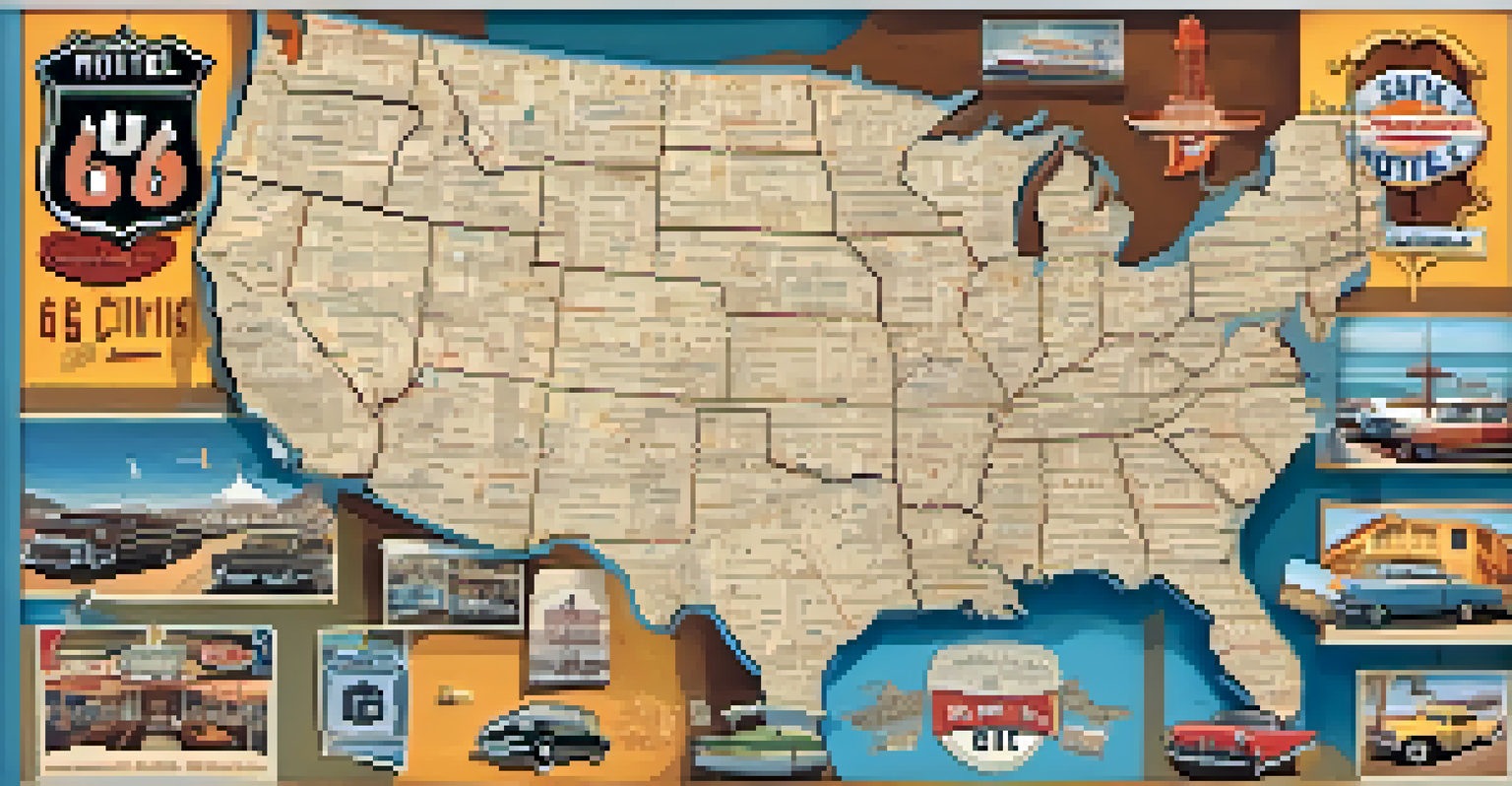The History of Route 66: California's Journey Through Decades

The Birth of Route 66: A New American Highway
Route 66, often called the 'Main Street of America,' was established in 1926. It connected Chicago to Santa Monica, spanning over 2,400 miles. California played a vital role in this highway's story, showcasing its stunning landscapes and diverse culture.
The journey is the destination.
The highway was initially designed to facilitate the movement of goods and people, making it a lifeline for many communities. As families began to travel during the Great Depression, Route 66 became a symbol of hope and adventure.
With the rise of automobile travel, the highway flourished, and roadside attractions began to pop up, turning it into a popular destination for road-trippers looking for unique experiences.
The Golden Age of Route 66: A Cultural Hub
By the 1950s, Route 66 had become a cultural phenomenon, representing freedom and the American dream. Travelers would stop at diners, motels, and attractions, creating a vibrant roadside culture.

California's segment of Route 66 offered a blend of natural beauty and urban excitement, with attractions like the iconic Santa Monica Pier. This era solidified Route 66's place in American pop culture, inspiring songs, movies, and literature.
Route 66: A Symbol of Freedom
Route 66 embodies the spirit of adventure and exploration, representing the American dream and freedom for countless travelers.
The highway was more than just a road; it was a journey filled with stories and experiences, where every stop held a piece of history and adventure.
Challenging Times: The Impact of the Interstate System
The late 1950s brought significant changes with the introduction of the Interstate Highway System. This new network prioritized speed and efficiency, leading to a decline in traffic along Route 66.
Life is a journey, not a destination.
Many small businesses that thrived on the route faced challenges as travelers opted for faster, more direct routes. The charm that once attracted visitors began to fade, leaving behind abandoned motels and forgotten attractions.
Despite these challenges, the spirit of Route 66 persisted, as nostalgia began to draw travelers seeking a taste of Americana.
Revival Efforts: Preserving Route 66's Legacy
In the 1980s and 1990s, efforts to preserve Route 66 gained momentum, with communities recognizing its historical significance. Local organizations and enthusiasts began restoring landmarks, ensuring the highway's story would not be forgotten.
California saw the establishment of Route 66 associations, which worked tirelessly to promote the route as a historical and cultural treasure. These initiatives sparked renewed interest from tourists eager to explore the iconic highway.
Challenges of the Interstate Era
The rise of the Interstate Highway System in the late 1950s led to a decline in traffic on Route 66, impacting many small businesses along the route.
Through festivals, events, and restoration projects, Route 66 was once again celebrated, inviting a new generation to experience its charm.
Modern Day Route 66: A Blend of Old and New
Today, Route 66 is a mix of nostalgia and modern tourism. Travelers can experience vintage diners next to contemporary attractions, creating a unique juxtaposition of past and present.
California's section of Route 66 continues to draw visitors, offering scenic drives through the Mojave Desert and vibrant cities like Los Angeles. The highway is a living testament to American history and culture.
Road-trippers can explore quirky roadside attractions and historic sites, ensuring that the spirit of adventure remains alive along this iconic route.
The Role of Route 66 in American Identity
Route 66 has transcended its role as a mere highway; it has become an integral part of American identity. For many, it symbolizes freedom, exploration, and the open road.
The highway's influence is seen in everything from music to literature, reflecting the dreams and aspirations of countless travelers. It serves as a reminder of the journey, not just the destination.
Revival and Preservation Efforts
Recent efforts to preserve and promote Route 66 have reignited interest, allowing new generations to experience its historical and cultural significance.
As people continue to share stories and experiences along Route 66, its legacy lives on, reinforcing its place in the heart of America.
Future of Route 66: Continuity and Change
Looking ahead, the future of Route 66 depends on a balance of preservation and adaptation. As tourism evolves, there are opportunities to enhance the experience while respecting the highway's history.
Communities along Route 66 are finding innovative ways to engage visitors, using technology and social media to tell their stories. This approach not only attracts tourists but also fosters a sense of community pride.

Ensuring that Route 66 remains relevant will require collaboration between local businesses, government agencies, and preservationists, keeping the spirit of this iconic highway alive for generations to come.